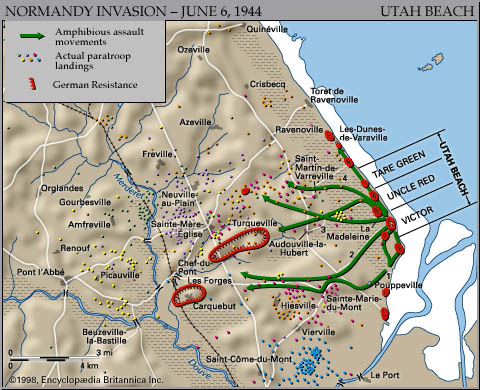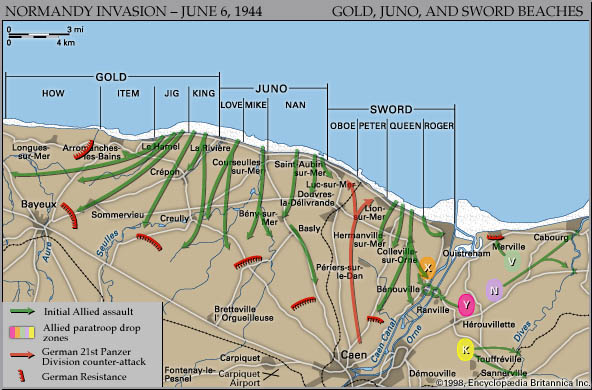|
|
|
Juno Beach
Juno was the code name for the second beach from the left of the five landing areas of the Normandy Invasion. The beach was 6 miles (10 kilometers) wide and stretched on both sides of the fishing port of Courseulles-sur-Mer. Two smaller villages, Bernières and Saint-Aubin, were east of Courseulles. Smaller villages were behind the sand dunes and had been strengthened by the Germans with casemates and adjacent fighting positions. The first hazard for the invaders at Juno, however, was not the Germans but offshore reefs. These forced the assault waves to land later in the morning than they had planned: H-Hour was set for 0745 hours, so that the landing craft could clear the reef on the rising tide.
Sword Beach
Sword was the code name for the extreme left beach of the five landing areas of the Normandy Invasion. It covered a 5-mile (8-kilometre) stretch of the French coastline from Lion-sur-Mer on the west to the city of Ouistreham, at the mouth of the Orne River, on the east. The area had a lot of vacation homes and tourist sites behind a seawall. It was about nine miles north of the hub city of Caen. All major roads in this part of the country went through Caen, and it was a key city to both the Allies and the Germans. The Germans had gotten the area ready with light defenses made up of beach obstacles and forts in the sand dunes.
Utah Beach
Utah was the code name for the farthest beach on the right of the five landing areas of the Normandy Invasion. It was on the eastern shore of the Cotentin Peninsula, and it was a late addition to the areas planned for invasion. The original Overlord plan did not call for a landing on the Cotentin, but General Dwight D. Eisenhower, supreme commander of the Allied Expeditionary Forces, added it to make sure that the port of Cherbourg at the northern tip of the peninsula was captured. The Utah landing area was three miles (5 kilometers) wide. The German defenses at Utah were very light because the low-lying areas just behind the landing area were flooded and the Germans could control the flooding with locks. Four causeways exited the beach through the flooded lowlands and made it very hard to move inland.

Utah Beach Invasion Plans

Juno, Gold, and Sword Invasion Plans
The Boring Stuff
BIBLIOGRAPHY
www.bbc.co.uk/education/archive/voyager/history/ww2_dday.shtml
www.history.cc.ukans.edu/heritage/abilene/ikedday.html